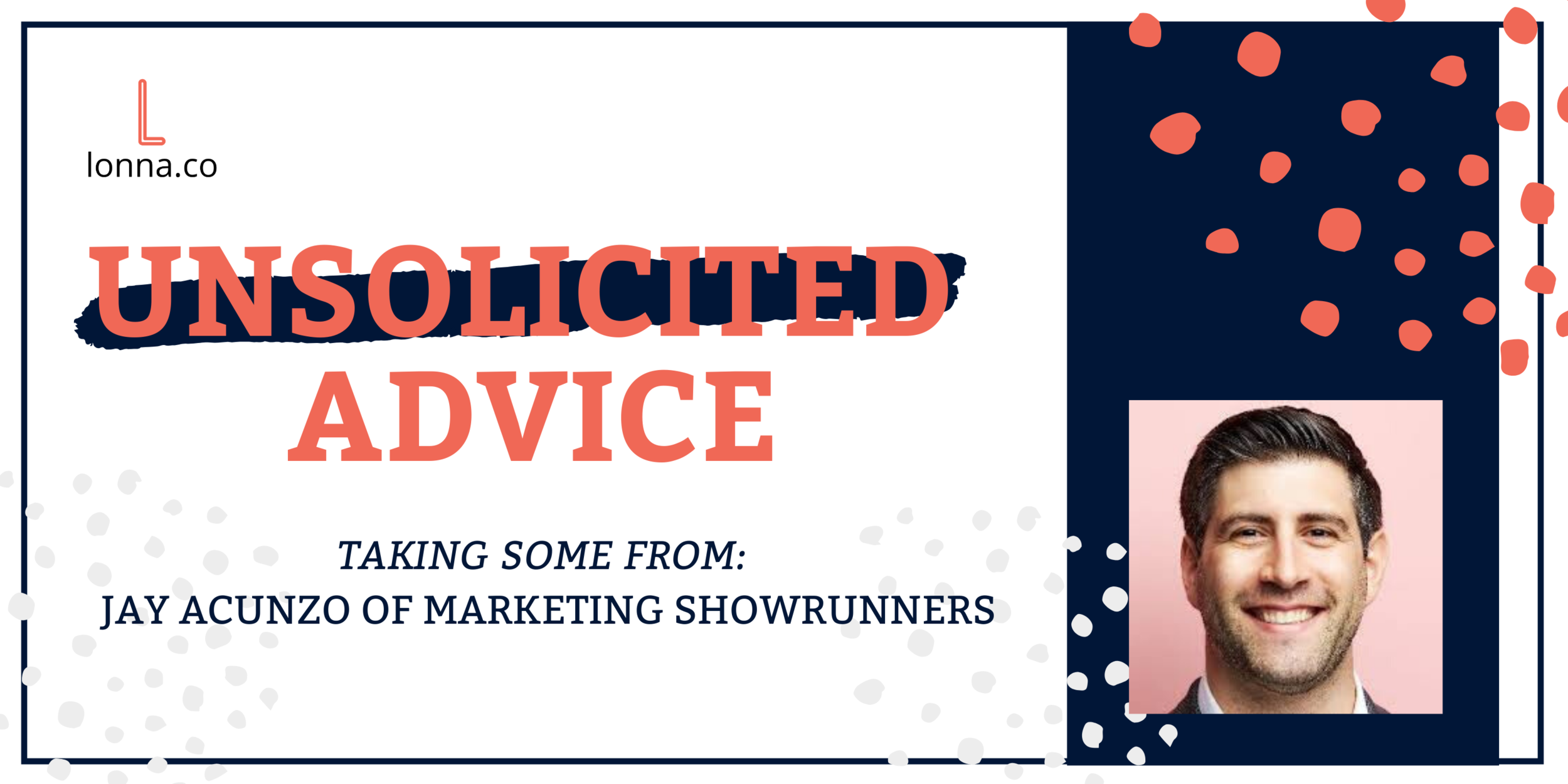What Happens When You Make an Empathy Statement
Podcast expert Jay Acunzo, one of my favorite people to follow on Twitter, recently tweeted this:
Your podcast's Empathy Statement is a crucial piece of the show's development and ability to grow community around it.
It answers a crucial question the audience will have: "Why is this for me?"
Have you written an Empathy Statement? Consider it.
Although the tweet, which introduces a blog post geared towards developing a solid premise for podcasts specifically, I felt the questions and advice Jay conjured up is incredibly valuable to other areas of our marketing efforts, too. (Like blogs and home pages and emails and all the marketing jazz!)
So I took Jay’s unsolicited advice to develop my own Empathy Statement for lonna.co.
So I thought it would be easy.
So it was totally not easy. Not even a little.
Here’s what happened.
Searching for the “One Story”
Jay’s piece on Marketing Showrunners (required reading, BTW) engages in a very deep and important question: “What is Our One Story?”
We often discover Our One Story (OOS) by first defining our mission, vision and values. This helps us distill our core messaging. It helps us build an audience, which helps us build community (the holy grail of modern marketing).
Inspired by the mystical, magical Anthony Bourdain (RIP), Jay explores the intersection of our brand experience and why it matters to our customers and clients. He says:
“As makers and marketers, we face a choice: we can play into the status quo, or we can push people to be better. If we choose the former, we often assume an air of ‘smug clarity,’ that we have answers others seek. But the path of making things better? That promises each of us far fewer moments of smug clarity, that’s for damn sure.
“When we strive to make things better for others, we aren’t likely to stand at the end of a path, shouting backwards to those we aim to serve. ‘I’ve made it! I know the answers! Come this way! I can teach you.’ ” ~ Jay Acunzo
In my words:
If you’re knee deep in status quo, you’re assuming you are the keeper of everything your customers want. You are the pusher. You are allowing the customer to ask, “What’s in it for me?” Perhaps you are allowing them to ask this without a clear answer or path for them, though you’re faking it anyway.
Or, if you’re willing to open yourself up to truly making things better, you put yourself on the journey to help empower the customer. You are the guide. You are allowing the customer to ask, “Why is this for me?” Perhaps you are on the path with them.
But what if you don’t have just one story?
If you haven’t discovered your one story yet, I think that’s OK, especially if you’re a new business like lonna.co. Startups have an advantage, too, because by following the Minimum Viable Product (MVP) process, they get to develop a lot of their story as they go.
Plus, having too many stories is better than faking it
I once worked for a boss who would tell potential clients we could do “everything” for them, including some stuff none of us on the team had ever done before. He wanted the potential client to think we could solve all their problems. He saw the world with “smug clarity.” He was a pusher, not a guide.
My point is, no matter where you are with your own business, let yourself off the hook if you don’t have all the answers. In fact, nobody wants to do business with someone who has ALL the answers, because having ALL the answers is literally impossible.
You might not ever be done with your one story.
In all likelihood, you will always be a story in progress. What an amazing revelation!
What is empathy, really?
Yes, it feels great to have answers and solutions. But what often feels even better is to say, “You know what? I don’t know. Let me do some digging and find out for both of us.”
What Jay’s tweet suggests is that we can often develop a fantastic brand premise when we empathize with our ideal customers. To be a guide (not a pusher), we have to have empathy, but do we really even know what true empathy is? What it takes to truly empathize?
Let’s explore.
How often do you hear people say, “I can empathize with that” or “I have a deep sense of empathy”? Yet, how often are these people really, truly feeling empathy? Less than you think, but only because our definition of empathy is a little wrong. What most people call empathy is really sympathy.
So what is empathy and what is sympathy? Here’s a definition I love:
“Empathy is often defined as understanding another person’s experience by imagining oneself in that other person’s situation: One understands the other person’s experience as if it were being experienced by the self, but without the self actually experiencing it. A distinction is maintained between self and other. Sympathy, in contrast, involves the experience of being moved by, or responding in tune with, another person.”
For us regular folks, we might think we’re empathizing with someone when we’re really sympathizing. When we say, “I can’t imagine what you’re going through,” we’re sympathizing.
Often, we have to have lived a similar experience or hardship to truly empathize with what someone is enduring. But to sympathize, all that takes is being a human being with actual feelings. (What a concept!)
Creating an empathy statement
OK, so here’s where the hard work begins (thanks, Jay). With a full understanding of what empathy means in contrast to its emotionally distant cousin, sympathy (kidding; sympathy is very important, too), how do we go about creating an empathy statement for a business?
If you’re asking yourself, “Oh my god, is that even possible?” Don’t worry. I went through that stage, too. Here’s how I got past it.
Step one: Ask like an empath
If you’ve ever known a true empath in your life (I hope you’re lucky enough to have encountered one), you may characterize them as emotional or sensitive. An empath might be feeling all the feels, when we’re just over there like, “Wow, tough luck, buddy.”
So what kinds of questions can we ask ourselves that might help us understand how to empathize rather than sympathize? Here’s a list:
What emotions is this person (aka, ideal customer) experiencing?
When I experience these emotions in my own life, how do they make me feel?
What circumstances may have led to the person’s (aka, this ideal customer’s) emotions?
In what ways have my circumstances been similar?
The more you can draw parallels with someone else’s feelings in relation to your own life experiences, the more you can begin to feel empathy.
Step two: Express like an empath
Once you’re able to really put yourself in another’s shoes (apologies for the tired cliche), we can get a little closer to that Empathy Statement Jay talks about.
Bear witness to all the emotions a customer might feel when they’re searching for or considering your product or service.
Pro tip: Under zero circumstances should you ever make assumptions. Start with customer interviews, research competitor audience, build your community by truly listening, investigating, exploring.
Make a list of those emotions and understand them through your own experience.
Don’t fake it. Don’t push yourself to feel something you don’t. Go back to your research if you get stuck.
My Empathy Statement (is a total work in progress)
I wish I could offer you a final draft of my own Empathy Statement, but I can’t. The best I have at this moment in my journey as Lonna the Person and Lonna the Company is a deeply considered examination of how a customer might answer “Why is this for me?” at this particular moment in time.
Here’s my working draft:
The ideal community for your customers is a place where you can explore core truths, exchange knowledge and create delight together. My role in your company’s story is to guide your content to a place that feels authentic to you and just right for your community of customers.
My three takeaways
Here’s what I really got out of Jay’s unsolicited advice:
Don’t fake the feelings. If you can’t empathize with someone or a specific experience, look to the facts, interview customers, do your research.
Try to distill down to your One Story (for clarity and consistency), but be sure your story doesn’t have an ending. No matter how tidy your mission, vision and values, be sure your story is never in a final draft format.
Make things better, or at least try. You’re not going to win them all, but the best businesses never stop innovating. Never stop trying. Never stop asking questions.
Whew. We did it. Thanks for going on this unsolicited advice adventure with me and thank you, Jay Acunzo, for the amazing unsolicited advice!
Do you have a favorite piece of unsolicited advice?
I’d love to hear it and experiment with it if you’re willing to share. Just email me and we’ll get it in the hopper!

